Esta breve serie de seminarios web, desarrollada por el Arca de los Anfibios, proporciona un foro interactivo en línea donde los manejadores de programas ex situ de anfibios discuten algunos de los principales desafíos que los manejadores y cuidadores del programa enfrentan a medida que se esfuerzan por alcanzar sus objetivos de conservación. El contenido de los seminarios web sigue los pasos clave para establecer y mantener un programa de conservación ex situ de anfibios exitoso. Cada sesión dura 60 minutos.
El primer paso es tener éxito en obtener animales fundadores y mantenerlos en condiciones óptimas. Existen diferentes técnicas de muestreo que nos ayudan a encontrar animales fundadores, en el caso de que no se disponga de una fuente de individuos cautivos de otras instituciones. En uno de los seminarios web se presentará una visión general de la logística para realizar trabajos de campo remotos donde muchas de las especies prioritarias habitan.
La calidad del agua, la iluminación y la nutrición son algunos de los aspectos importantes de manejo de los que los manejadores de programas deben estar muy conscientes para que el programa tenga éxito. La bioseguridad también es muy importante, especialmente para los animales que eventualmente serán reintroducidos en la naturaleza. Estos temas serán cubiertos durante los seminarios.
Una de las estrategias de salida de cualquier programa de conservación ex situ de anfibios es la reintroducción de la descendencia a la naturaleza. Una de las técnicas de monitoreo posteriores a la liberación es la radiotelemetría, y una presentación durante la serie de seminarios web discutirá esta actividad.
Las siguientes presentaciones fueron desarrolladas en el transcurso de la serie. Haga clic en cada imagen de video para ver la presentación. El conjunto completo de videos también está disponible como una lista de reproducción en YouTube.
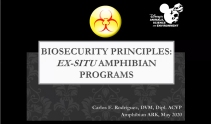
Biosecurity Principles: Ex Situ Amphibian Programs Carlos E. Rodriguez The role of biosecurity in any animal operation, particularly in amphibian programs, is of crucial importance. In this presentation we discuss the guiding principles and practical approaches to setting up a sound biosecurity plan taking into account the role and purpose of the species and the location of the facilities. We also discuss salient and important principles of disinfection techniques applicable to animal programs. Finally, we discuss the role of quarantine as a disease barrier to established programs and use of the risk assessment matrix to identify threats and direct how to apply these techniques. |
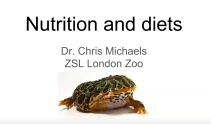
Christopher Michaels The diet used to maintain captive amphibians is a key component of husbandry and can make or break a program. In this talk, Chris looks at some of the fundamental principles and considerations to make when designing diets for captive amphibians as well as some guidelines on how to tailor diets to the species in question. |

Water quality in ex situ amphibian husbandry Christopher Michaels Amphibians are unique amongst terrestrial vertebrates in their strong ties to environmental water, and many species utilize aquatic habitats for at least part of their lives. This talk explores the fundamental components of water quality and chemistry, their relevance to maintaining amphibians in captivity, and how they can be managed in artificial systems. As amphibians have adapted to a wide variety of freshwater and hyposaline habitats, this information is designed to serve as a foundation of knowledge that can be applied to any husbandry situation, rather than a one-size-fits-all approach. |
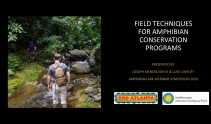
Field techniques for amphibian conservation programs Joseph Mendelson and Luke Linhoff Amphibian conservation often requires working in the field. Monitoring wild amphibian populations and being able to safely collect, transport and release animals are critical techniques for success. We review basics of field sampling techniques for biodiversity inventories and population monitoring protocols, with recommendations of technical references that have more detailed information. Biodiversity inventories and field monitoring (for example to track trends in a focal population or to assess status of reintroduction efforts) are very different tasks and involve different techniques that we discuss. |
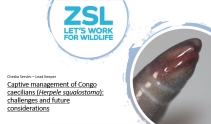
Francesca Servini Caecilians are a vastly understudied species, due to difficulties observing them in the wild and in captivity. The Zoological Society of London currently holds two species of caecilian: Congo Caecilians (Herpele squalostoma) and Cayenne Caecilians (Typhlonectes compressicauda). The Cayenne Caecilian is an aquatic species, and therefore is easier to study and has allowed us to observe breeding events in the past, however the Congo Caecilians are fossorial, which presents numerous husbandry challenges in captivity. This presentation discusses these challenges, what we have done to overcome them, and what our future aims are with our captive group in regards to better management and breeding. |
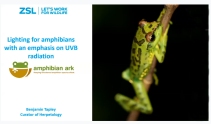
Lighting for amphibians, with an emphasis on UVB radiation Ben Tapley Light is a free and often plentiful resource and optimal levels of light are likely to be those experienced by animals in nature. This session will cover the basics on the provision of lighting for amphibians in captivity with a focus on adopting species-specific and evidence-based husbandry protocols. There will be a particular focus on the provision of UVB radiation. |

Catering to amphibian larval husbandry Christopher Michaels Amphibians often have larval phases in their life histories. Amphibian larvae are often so different in structure and ecology from their parents that they constitute different ecological species. As such, husbandry practitioners working with a species with a larval phase must consider the husbandry of the larva as closely as the adult. This talk looks at some of the basic principles and practical tips for rearing amphibian larvae in captivity. |

Experimental approaches to improve ex situ conservation of anurans Richard Preziosi This talk presents a series of studies examining how we can develop an evidence base for improving ex situ husbandry. It focuses on aspects of enclosure design and on the delivery and effect of carotenoid supplementation in the diet. |







